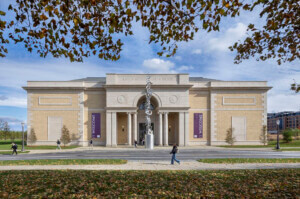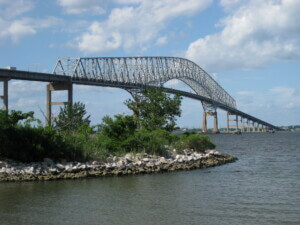To some cross-country travelers, Louisville, Kentucky, is considered the gateway to the East. For Southerners, it serves as a transition into the Midwest. From whichever direction you approach the city, it’s a metropolitan area that grants access to other major cities like St. Louis, Nashville, Cincinnati, and Pittsburgh. But it’s not just a pivotal bypass, it’s also a place where people actually live.
As the symbolic southern border for Indiana, it’s home to tens of thousands of drivers who cross the Ohio River every day for work and play, making Louisville’s four major bridges vital to supporting the economies of two separate states.
Over the last decade, Kentucky and Indiana spent $1.3 billion on a 12-lane highway widening project that spliced through several new and old neighborhoods in downtown Louisville in an effort to ease congestion that’s long plagued commuters. The plan was part of the massive Ohio River Bridges Project that rehabilitated the I-65/John F. Kennedy Bridge and built out the new, cable-stayed Abraham Lincoln Bridge that stretches northbound over the Ohio River. According to Streetsblog, the project was critical to Louisville’s growth, but since officially reopening in late 2016, the Kennedy Bridge has proven of little use to drivers.
Per a post-construction study released by the State of Indiana, traffic has fallen 49 percent on the Kennedy bridge, which requires drivers to pay up to a $4 toll. Traffic has subsequently increased by 75 percent on the nearby US 31 Clark Memorial Bridge, a 90-year-old piece of infrastructure that’s completely free.
It’s no surprise that people are essentially boycotting the billion-dollar “transportation boondoggle,” as one local urbanist called it. The project received wide criticism from the start. Streetsblog reported that in 2013 a grassroots group got 11,000 people to sign a petition in support of tearing down the highway instead of expanding it. But with backing from two state governments, it was eventually built. Taxpayers will be paying for the project until 2053.
The result is a half-used bridge and a messy mixture of reconstructed roadway known as Spaghetti Junction. Louisville’s crisscrossed 64, 65, 264, and 71 interstates were always tricky to navigate and still are despite this recent update. Throughout construction, thirty-three acres of urban forest and 30 storefronts in mostly minority neighborhoods were destroyed. Historic buildings were also leveled for the revamped highway system. In spite of plowing through these surrounding communities, the project has received national accolades.
There are bad highways projects and then there’s this…
I visited Louisville with @cnunextgen in 2014 & remember thinking this project couldn’t be real.
$1.3 billion later… traffic volume has been cut in half, riverfront is cut-off & development has been hindered. https://t.co/5u8415JMEB
— Nate Hood (@natehoodstp) November 28, 2018
Louisvillians lament that new highways won’t solve the city’s congestion problems, though the increased number of options to pass through the city are a bonus for anyone who doesn’t wish to make a pitstop on their way somewhere bigger and better. It’s a classic, tragic story that’s hurt many American cities suffering from mid-century highway build-outs. Some are making concerted efforts to replace aging infrastructure with beautiful boulevards and walkable, shared streets, but others aren’t thinking as clearly about how to keep people in town, as opposed to letting them drive on by.
Kentucky’s busiest bridge, the Sherman Minton, sits further outside downtown than its counterparts. As the city’s only toll-free link to Indiana, it sees 90,000 drivers per day. The 56-year-old structure is slated to begin a $90 million rehabilitation project in 2021. Time will tell whether or not its partial or full closure during construction will force people to start crossing the newer structures that spew out of the city’s core. The Indiana Department of Transportation and the Kentucky Transportation Cabinet just ended a public input period to figure out next steps. A recommendation will be made next fall.











